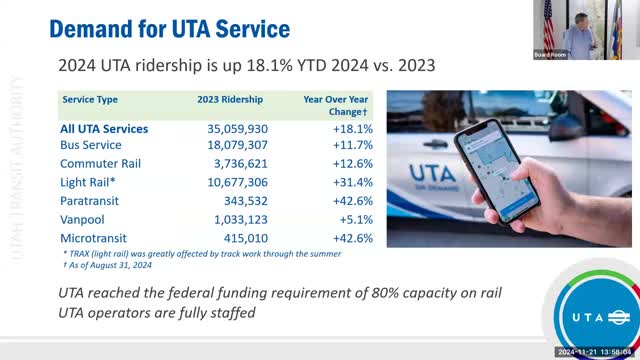UTA reports 16% rise in ridership as budget plans for new service begin
April 27, 2025 | Transportation Coordinating Committee, Wasatch Front Regional Council, Wasatch County Commission and Boards, Wasatch County, Utah
This article was created by AI summarizing key points discussed. AI makes mistakes, so for full details and context, please refer to the video of the full meeting. Please report any errors so we can fix them. Report an error »

Ridership on Utah's transit system is surging, with utility ridership up by over 16% compared to previous months, marking a significant rebound since the pandemic. This increase has positioned Utah Transit Authority (UTA) as a leader in national transit recovery, ranking fourth in the country for ridership growth in 2023, with expectations to climb even higher in 2024.
During a recent Transportation Coordinating Committee meeting, officials highlighted that peak commuter rail services are operating at 80% capacity, a milestone that underscores the effectiveness of UTA's services. The rise in ridership is attributed not only to improved transit services but also to changing land use patterns, with more residential and commercial developments emerging near transit hubs.
The meeting also revealed a generational shift in transportation habits, with younger individuals less inclined to obtain driver's licenses, leading to increased reliance on public transit. A recent survey of planning students showed that 80% had used the UTA system in the past week, indicating strong engagement among the youth.
Financially, UTA is navigating a modest budget landscape, primarily funded by sales tax, with a focus on maintaining existing infrastructure while planning for new services. The agency is set to introduce additional local services in April 2025, which will require hiring more operators and expanding its fleet.
Moreover, UTA is investing in electric buses and the necessary charging infrastructure, aiming for a fleet that is 50% electric or natural gas over the next two decades. This transition is part of a broader strategy to enhance service efficiency and reduce environmental impact.
As UTA continues to adapt to changing ridership patterns and economic conditions, the agency remains committed to providing reliable and accessible transportation options for Utah residents, reinforcing its role as a vital component of the state's infrastructure.
During a recent Transportation Coordinating Committee meeting, officials highlighted that peak commuter rail services are operating at 80% capacity, a milestone that underscores the effectiveness of UTA's services. The rise in ridership is attributed not only to improved transit services but also to changing land use patterns, with more residential and commercial developments emerging near transit hubs.
The meeting also revealed a generational shift in transportation habits, with younger individuals less inclined to obtain driver's licenses, leading to increased reliance on public transit. A recent survey of planning students showed that 80% had used the UTA system in the past week, indicating strong engagement among the youth.
Financially, UTA is navigating a modest budget landscape, primarily funded by sales tax, with a focus on maintaining existing infrastructure while planning for new services. The agency is set to introduce additional local services in April 2025, which will require hiring more operators and expanding its fleet.
Moreover, UTA is investing in electric buses and the necessary charging infrastructure, aiming for a fleet that is 50% electric or natural gas over the next two decades. This transition is part of a broader strategy to enhance service efficiency and reduce environmental impact.
As UTA continues to adapt to changing ridership patterns and economic conditions, the agency remains committed to providing reliable and accessible transportation options for Utah residents, reinforcing its role as a vital component of the state's infrastructure.
View full meeting
This article is based on a recent meeting—watch the full video and explore the complete transcript for deeper insights into the discussion.
View full meeting

